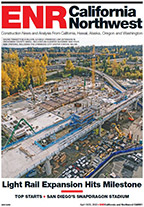The facility, as designed, has three main roof elevations. The lowest, like a skirt, consists of sloped, downward-pointing triangular panels that bend, like a rigid drape, to become facade panels. Near the base, the panels alternate with the operable-glass curtain wall.
The fixed roof steps up to a flat plane—in plan, a broad, eight-pointed star with a 385-ft x 310-ft center hole. The uppermost roof elevation is the operable portion. In the closed position, eight triangulated and bent "petals" form a segmented oval, like slices of a pie, that cap the opening. In plan, when the petals retract over the fixed roof, they resemble a giant pinwheel.
All the panels are clad in ethylene tetrafluoroethylene (ETFE), a lightweight, fluorine-based plastic that has high corrosion resistance and strength over a wide temperature range. ETFE can be transparent, like a window, or translucent.
After deciding to go for the job, Johnson approached Hatfield. "I said, 'This may sound crazy, we might not make the short list, but would you be willing to throw your hat in the ring?'" he recalls.
Her answer was yes. Hatfield, a 23-year veteran of structural engineering, had long dreamed about designing a retractable roof. Hoberman soon joined to advise about roof kinetics. "Chuck became a muse for this project," says Johnson. Hatfield adds, "He helped us get off the original idea of rotational movement, which is tough to execute on such a large scale."
BH principal Craig Schwitter, who, in 1999, opened the North America office of the London-based multidisciplinary engineer, soon suggested that an oval opening would better reflect the rectangular field.
Hatfield calls the circle-to-oval switch "Craig's complete disruption" because it further complicated the structure by reducing repetition and forcing a nonorthogonal grid. Variations in petal sizes meant unequal forces on the supporting trusses, which increased analysis time by 20% to 30%, says Hatfield.
To develop the geometry, Johnson credits as instrumental the use of a graphical algorithm software editor, called Grasshopper, in conjunction with 3D modeler Rhinoceros. Both digital tools were developed by Robert McNeel & Associates.
The roof structure grew from the architecture. The flat, fixed-roof structure, which will contain 10,100 tons of primary steel, is a two-way system with a criss-cross pattern, in plan, of primary, secondary, backspan and gutter box trusses. The four primaries, each 70 ft deep with a 12-ft-deep top chord, look, in plan, like a racked tick-tack-toe board.
The primaries are planned as the main support for the fixed and movable roofs. Each spans 715 ft between reinforced-concrete, 179-ft-tall megacolumns, sited just outside the seating bowl. Megacolumn plan dimensions vary from 21 ft x 19 ft to 29 ft x 14 ft.
The primaries will span diagonally across the corners of the field to frame the corners of the opening. They support the inner travel rails of four of the eight cantilevered petals near each petal's back section, or heel. They also support the 58-ft-tall video halo.
Four 70-ft-deep secondary box trusses, also with a 12-ft-deep top chord, will complete the framing of the opening and provide support for the other four petals' inner rails. Each secondary truss will span from a primary truss to its own megacolumn.
Each petal is framed by three main trusses, which taper from 30 ft deep at the heel to 4 ft at the tip, to shape the roof slope. The petals are from 196 ft to 232 ft long and 128 ft to 160 ft wide. They cantilever 156 ft to 192 ft from the primaries, which they overlap by 40 ft. The cantilever puts a downward force on the inner travel rail and an upward force on the outer rail, which is supported by a backspan truss. Each backspan truss spans from a primary truss to yet another megacolumn.
The petals appear to open like a camera shutter. By moving together on the diagonal, they create an illusion of circular motion. The travel mechanism, thanks to the synchronization controls, is the most complicated and most expensive—by 20% or 25%—of his six completed operable roofs, says Bart Riberich, president and owner of mechanization consultant Uni-Systems Engineering Inc. A major technical challenge is coordinating the deflections of the fixed and movable roofs, thanks to the long and broad spans, adds Mark Silvera, Uni-Systems' vice president.










Post a comment to this article
Report Abusive Comment